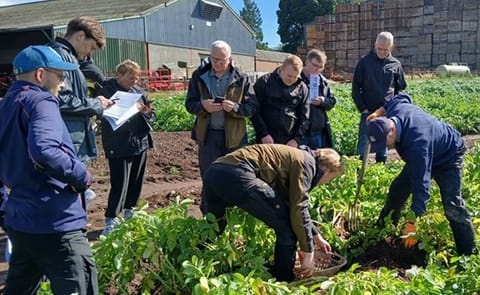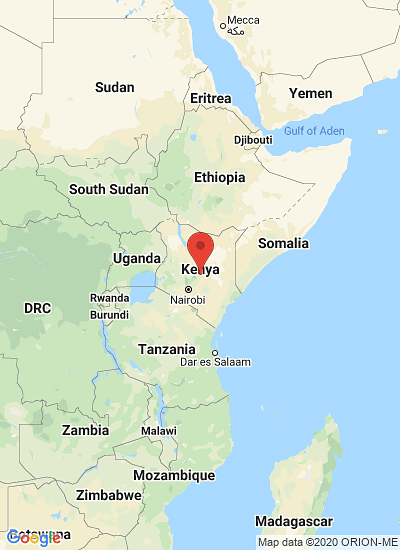A young farmer inspect his potato plantation in Eldama Ravine, Baringo. Potato Cyst Nematode (PCN), a deadly pest currently ravages potato crops in several counties in Kenya (Courtesy: Daily Nation)
Potato Cyst Nematodes threaten crop in Kenya

Infestation of potatoes by the Potato Cyst Nematode (PCN), a pest ravaging potato plants that was discovered in Kenya two years ago, has reached alarming levels.
A survey done in 20 counties through support from United Nations Food and Agricultural Organisation (FAO), whose results were released two weeks ago, shows that PCN infestation has reached 80 per cent to 100 per cent in some of the potato growing areas.
The study shows that the future of potato production is bleak unless the government takes emergency measures to stem the rapid spread of the devastating pest.
PCN (Globodera rostociensis or Globodera pallida) is classified as a quarantine pest by FAO, meaning that in countries where it is detected, tough restrictions are imposed.
This include ban on potato production and transport to other growing regions and even countries to stop spread. The pest can remain in the soil for up to 30 years.
Infested potatoes usually show early maturity, produce tiny tubers and are usually stunted. Up to now, there is no known chemical or biological agent that can control the pest.
Nyandarua leads with a prevalence rate of 91 per cent followed by Elgeyo Marakwet (87 per cent), Nakuru 88 per cent and Narok (88 per cent).
Other counties with high infestation levels are Trans-Nzoia (100 percent), West Pokot (100 percent) and Taita Taveta (100 percent).
However, the three are not major potato producers. Of the 1,200 potato growing farms sampled in the survey, only four that produce seeds were found to be free of the pest.
Importation of whole potato tubers into the country has been blamed for the introduction of the pest. The Kenya Plant Health Inspectorate Service (Kephis) is supposed to ensure that any potato seed brought in has to be in form of in-vitro plantlets that are quarantined at its station in Muguga and tested for pests and diseases before being put in experimentation plot for trials and eventual release as seeds as stipulated under the Seed and Plant Varieties Act Cap 325.
However, the Ministry of Agriculture has at times gone around this requirement and allowed imports of potatoes from Netherlands and other European countries into citing potato seed shortage.
An important Crop
The government can only produce about 1 per cent of potato seed required while 99 per cent used by farmers is uncertified, which has been blamed for the rapid spread of diseases and pests such as PCN.
The survey has established that all government seed production units run by Kenya Agriculture and Livestock Research Institute are infested with PCN.
This includes seed multiplication sites in the Agricultural Development Corporation farms. This means that the government cannot be able to produce any seed in future unless new seed production areas that are not affected by the pest are identified.
Deputy Director in-charge of Phytosanitary Services at Kephis Dr Issac Wachira said the body had overlooked the inspection of PCN in all planting material coming into the country because it was mainly prevalent in Europe and other temperate countries.
He said going forward, strict inspection of all plant material both for export and imports will be enforced to protect the country from re-infestation.
Dr Issac Wachira, Deputy Director in-charge of Phytosanitary Services at Kephis:
“We had put our attention so much on potato diseases such as bacterial wilt in seed potatoes in our inspection work because we did not know that PCN was already in Kenya.”
“From now on, we will enforce strict inspections of all material coming into the country to ensure the pest is contained.”
“We are aware that infested potted plants, packaging material, flower bulbs and even farm implements can transfer the pest from one region to another.”
The Head of the Crops Unit at FAO (Kenya) Dr Wilson Rono asked all stakeholders in the potato industry to use the results of the survey to come up with a common strategy to combat the pest to stop its spread and restore potato production in the country to its former status for food security.
Potato is the second most important crop in the country after maize.
It is grown by more than 800,000 farmers generating more than Sh50 billion to the country.
The survey was conducted by ICIPE in collaboration with Kalro, Kephis, Kenyatta University, the International Institute of tropical agriculture (IITA) and the Ministry of Agriculture Livestock and Fisheries.









